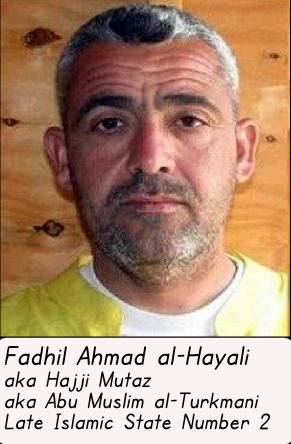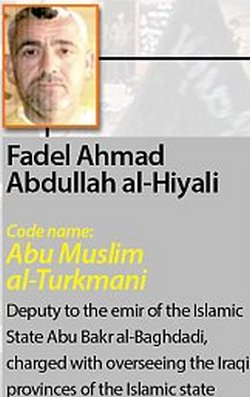[Jpost] 'ISIS top brass is Iraqi army's former best and brightest." The Associated Press piece by Hamza Hendawi and Qassim Abdul-Zahra informs us that the "experience" these officers bring to Islamic State (IS, also ISIS or ISIL) help provide it discipline and military prowess.
The evidence provided by the authors was that army officers of the current Iraqi government had blamed their inability to stop IS on the presence of these Saddam military experts. Ali Omran, who now serves in Iraq's 5th division, claimed that an old artillery major he knew was serving with the Islamists now. The article claimed Saud Mohsen Hassan, who also goes by the names Abu Mutazz, Abu Muslim al-Turkmani and Fadel al-Hayali, was a Saddam-era major and now is the IS "second in command." Four of nine members of the IS military council were Saddam-era officers. Seven of 12 IS provinces even has governors who served in the Ba'ath army. In total there might be as many as 100- 160 Saddam-era soldiers in the IS ranks, according to the report.
A short review of the "evidence" = unsupported statements by various Iraqi "experts", and its coverage by western press
...LET'S PAUSE and digest all this. 140 or so men who served under Saddam are thought to play a role in middle or senior ranks of IS. Three Saddam-era officers ended up in the top six ranks of IS. Here we find Abu Ayman al-Iraqi, a former colonel in the air defense, Haji Bakr and Abu Ahmed al-Alwani, whose real name is Waleed Jassem al-Alwani, a former Saddam-era soldier.
When one considers how large Saddam's army was, it would be surprising if IS didn't have a plethora of former Saddam-era soldiers. Just the elite units in Saddam's disbanded army included 30,000 commandos, tens of thousands of Republican Guard and trained "fedayeen," or guerrilla fighters who were supposed to lead the insurgency. Saddam's elites were Sunnis, precisely the people disaffected under Nuri al-Maliki's Shi'ite-led government. But what was this "formidable" military experience they brought to help IS? If they had fought in the Iran- Iraq war they would today be in their fifties or older.
Most of these men came of age when Saddam's army was withering on the vine in the 1990s, and they spent 10 years supposedly unemployed from 2003 to 2013, when they decided to secretly become the backbone of IS? Why had they been such dismal insurgents for those 10 years, only then suddenly finding their stride? The truth is that a story of a Ba'athist hidden hand has been packaged and provided by sources in Iraq and Syria, primarily those who support the Iraqi government, are connected to its army or support the Shi'ite militias, in order to excuse the abject failure of the Iraqi central government; "Saddam is back, please help us, it's not our fault." Other sources have little credibility and are passed off by journalists as if they give some sort of real evidence.
The Iraqi army, that received hundreds of millions of dollars in equipment and training from the US, melted away in 2014. It surrendered thousands of US armored vehicles and Humvees to IS.
So we are to believe that a few Saddam-era colonels, majors and captains, artillery officers and air defense intelligence honchos swept aside thousands of vehicles, literally whole divisions, in their 2014 offensive? The same men who were so incompetent under Saddam? What is a Saddam-era "air defense colonel"? What air defense? His air defense achieved nothing. Saddam's intelligence services were good, but what does that have to do with IS ability to destroy the Iraqi army and withstand the bludgeoning of Iranian-backed Shi'ite militias? IS is a formidable fighting force in a sense, because its enemies are often so worthless. IS emerged in Iraq and Syria because of a backbone of Sunni supporters who were disenfranchised or disillusioned by the insurgency against Maliki and Syrian President Bashar Assad. When it came up against Kurdish fighters, after initial gains, it was defeated. The Kurds complained that their real problem fighting IS was lack of armored vehicles and anti-armor weapons, because ISIS had stolen so much American equipment. In small-unit battles IS was not superior to Kurdish peshmerga militia, who had learned their tactics fighting Saddam.
My personal view is that ISIS crisis been deliberately inflated by the "West" to justify rapprochement with Iran |
 [RUDAW.NET] The Islamic State group’s (ISIS or ISIL) second-in-command was killed in an airstrike by the US-led coalition in Mosul, the city in northern Iraq that has been in ISIS hands for more than a year, US and Iraqi officials announced Friday.
[RUDAW.NET] The Islamic State group’s (ISIS or ISIL) second-in-command was killed in an airstrike by the US-led coalition in Mosul, the city in northern Iraq that has been in ISIS hands for more than a year, US and Iraqi officials announced Friday.
 [ENGLISH.ALARABIYA.NET]
[ENGLISH.ALARABIYA.NET]  reportedly served as a deputy to Baghdadi, the self-styled "caliph" of ISIS which seized large swathes of Iraq and Syria earlier this year that prompted a U.S.-led coalition military response.
reportedly served as a deputy to Baghdadi, the self-styled "caliph" of ISIS which seized large swathes of Iraq and Syria earlier this year that prompted a U.S.-led coalition military response.